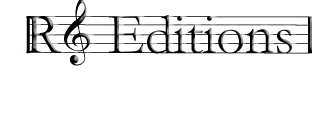
17th and 18th century
chamber music
scholarly, practical, value for money
... some technical stuff ...
These days, almost everybody in music has some sort of music editing program - and there are plenty to choose from, from the big expensive heavyweights like Sibelius and Finale, and smaller open source programmes like Lilypond. But back then, when I started typesetting, there was not so much around.
I've never been a Windows fan (never owned a PC, other than an ebay "bargain" to tinker with), and my computer at the time was an Acorn Archimedes. Now that was a fun machine. 9 MB RAM, with a 60 MB Hard disk (and, yes, that really is Megabytes, not GB!!!). It was blisteringly fast, I never got an out-of-memory message, and when I moved to Apple, after many years use, the Hard disk was still only half full. Ah, the price of progress
But I digress! I used a program called Philip's Music Scribe, developed by Philip Hazel - still around, now called Philip's Music Writer, about which you find out more here. It's a text-entry program (you input the notes etc as letters and symbols, and send the text file to PMW to be compiled ). It's a great program, and the first of my editions were all made with PMS.
Then Sibelius (Sibelius 7 at the time) came on the scene. Not that I was unhappy with PMS, but there were a few issues. First, certain music publishers with whom I was in contact explained that the font used by PMS was not up to their standards (still not sure that I understand quite why) -- but that Sibelius satisfied their requirements. Secondly, Sibelius was a WYSISYG program - which back then was AMAZING. And it was developed for the Acorn Archimedes RISC OS machines and was so fast it was funny!!
Sibelius 7 was written in machine code specifically for the arm "RISC" (reduced instruction set chip) - which was why it was SO FAST. But that restricted it to one computer, so with the first major upgrade, it was coded in C++ : sadly just at the time that Acorn and the Archimedes weren't doing so well, and there was no C++ compiler available, and Sibelius moved over to Mac and Windows. So, obviously no competition there, and I moved over to Apple Mac in 2000 or so.
Since then Sibelius has gone through various upgrades, becoming ever more powerful (although no where near as fast as it was in the good old days on the Acorn!!). Luckily, in spite of all the additional capabilities (many of which I do not need), the output is still fantastic, and the flexibility of the program allows me to get my editions to look just how I want.
Of course, the program you use is important - but still, getting the notes into the machine, and then out onto the page is only the tip of the iceberg. The next stage is getting it into a physical form that you can buy. I started by using a local copy shop -- but it was very expensive, and after one particularly disastrous occasion (Leclair Op. IV), when the shop charged me over £800 for an appalling result, I ended up buying a heavy-duty photocopier, and doing all the reproduction myself. But the hours slaving over the copier were not fun. Then I met Franz Biersack of Edition Walhall, who suggested a partnership - and now my editions are printed by a very high quality shop in Magdeburg, and distributed by Edition Walhall (www.edition-walhall.de). I am now really pleased by the look and feel of my editions .. I am aware that maybe I should embrace the digital age, and make them available for instant purchase and download. But on the other hand, you would then need to print it out at home to play, and there is something hugely more satisfying about receiving a nicely bound volume, on real paper with a proper cover!! So for the time being, it remains that way. Order direct from Edition Walhall, and you'll get your music the good old-fashioned way in the post!!
So, that's what goes on technically with RG Editions, and now back to the story ...
